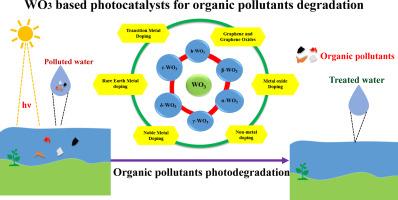wo3基光催化剂的功能化、性能及其在废水中有机污染物去除中的应用
IF 5.4
3区 化学
Q1 CHEMISTRY, INORGANIC & NUCLEAR
引用次数: 0
摘要
半导体金属氧化物是一种很有前途的光催化剂,可用于废水中有机污染物的降解。其中,氧化钨(WO3)光催化剂因其窄带隙、在酸性和氧化环境下的稳定性以及低毒性而备受关注。本文综述了wo3基光催化剂在去除水中染料、农药和药物等有机污染物方面的各种性能。此外,还概述了几种提高WO3光催化性能的策略,如金属和非金属掺杂,以及石墨烯和其他半导体金属氧化物与原始WO3的耦合。进一步深入探讨了wo3基光催化剂光催化降解染料、农药和药物化合物的机理。最后,对WO3光催化剂存在的问题进行了总结,并对如何提高WO3光催化降解能力提出了建议。本综述旨在支持设计可扩展的途径,通过可见光驱动的光催化使用WO3处理废水中的有机污染物。本文章由计算机程序翻译,如有差异,请以英文原文为准。

A review on WO3-based photocatalysts: Functionalization, properties and applications for the removal of organic pollutants from wastewater
Semiconductor metal oxides are promising photocatalysts for the degradation of organic pollutants from wastewater. Among them, tungsten oxide (WO3) photocatalyst has garnered significant attention due to its narrow bandgap, stability in acidic and oxidative environments, and low toxicity. In this review, WO3-based photocatalysts are thoroughly discussed in terms of their various properties for removing different organic pollutants, including dyes, pesticides, and pharmaceutical compounds from water. Moreover, several strategies, such as doping with metal and non-metal, and coupling graphene and other semiconductor metal oxides with pristine WO3, are outlined to improve the photocatalytic performance of WO3. Furthermore, the photocatalytic degradation mechanism of dyes, pesticides, and pharmaceutical compounds by WO3-based photocatalysts is explored in detail. Finally, some problems associated with WO3 photocatalysts are summarized and some suggestions are given to overcome the challenges to enhance the photocatalytic degradation capacities. This comprehensive review aims to support the design of scalable pathways for treating organic pollutants in wastewater via visible light-driven photocatalysis using WO3.
求助全文
通过发布文献求助,成功后即可免费获取论文全文。
去求助
来源期刊

Inorganic Chemistry Communications
化学-无机化学与核化学
CiteScore
5.50
自引率
7.90%
发文量
1013
审稿时长
53 days
期刊介绍:
Launched in January 1998, Inorganic Chemistry Communications is an international journal dedicated to the rapid publication of short communications in the major areas of inorganic, organometallic and supramolecular chemistry. Topics include synthetic and reaction chemistry, kinetics and mechanisms of reactions, bioinorganic chemistry, photochemistry and the use of metal and organometallic compounds in stoichiometric and catalytic synthesis or organic compounds.
 求助内容:
求助内容: 应助结果提醒方式:
应助结果提醒方式:


